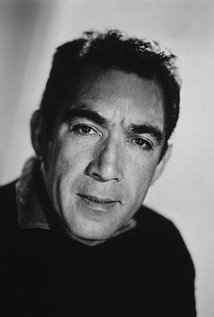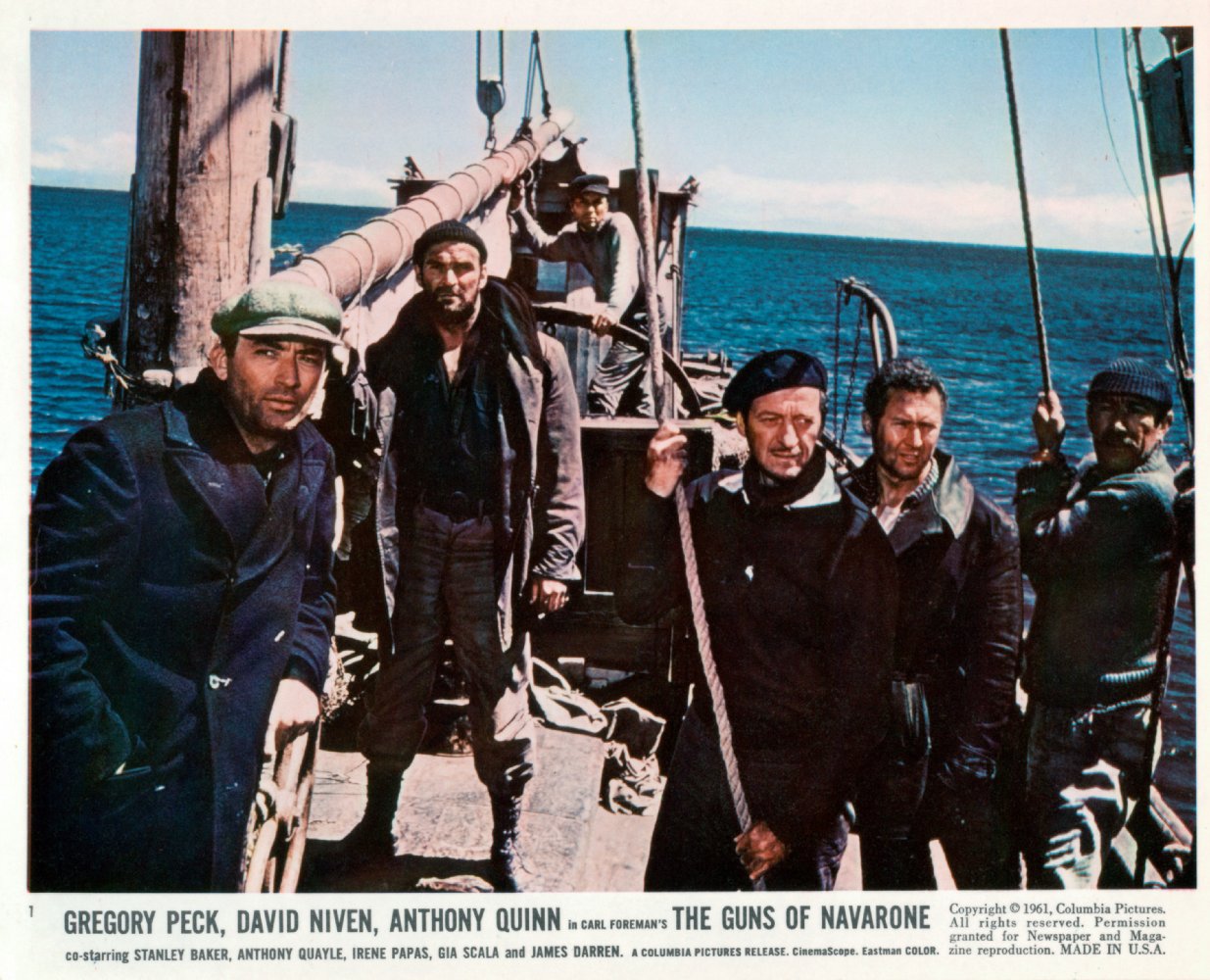
Anthony Quinn
Birthday:
21 April 1915, Chihuahua, Mexico
Birth Name:
Antonio Rodolfo Quinn Oaxaca
Height:
188 cm
Anthony Quinn was born Antonio Rudolfo Oaxaca Quinn on April 21, 1915, in Chihuahua, Mexico, to Manuela (Oaxaca) and Francisco Quinn, who became an assistant cameraman at a Los Angeles (CA) film studio. His paternal grandfather was Irish, and the rest of his family was Mexican. After starting life in extremely modest circumstances in Mexico, his fa...
Show more »
Anthony Quinn was born Antonio Rudolfo Oaxaca Quinn on April 21, 1915, in Chihuahua, Mexico, to Manuela (Oaxaca) and Francisco Quinn, who became an assistant cameraman at a Los Angeles (CA) film studio. His paternal grandfather was Irish, and the rest of his family was Mexican. After starting life in extremely modest circumstances in Mexico, his family moved to Los Angeles, where he grew up in the Boyle Heights and Echo Park neighborhoods. He attended Polytechnic High School and later Belmont High, but eventually dropped out. The young Quinn boxed (which stood him in good stead as a stage actor, when he played Stanley Kowalski in "A Streetcar Named Desire" to rave reviews in Chicago), then later studied architecture under Frank Lloyd Wright at the great architect's studio, Taliesin, in Arizona. Quinn was close to Wright, who encouraged him when he decided to give acting a try. After a brief apprenticeship on stage, Quinn hit Hollywood in 1936 and picked up a variety of small roles in several films at Paramount, including an Indian warrior in The Plainsman (1936), which was directed by the man who later became his father-in-law, Cecil B. DeMille.As a contract player at Paramount, Quinn mainly played villains and ethnic types, such as an Arab chieftain in the Bing Crosby-Bob Hope vehicle Road to Morocco (1942). As a Mexican national (he did not become an American citizen until 1947), he was exempt from the draft. With many actors in the service fighting World War II, Quinn was able to move up into better supporting roles. He had married DeMille's daughter Katherine DeMille, which afforded him entrance to the top circles of Hollywood society. He became disenchanted with his career and did not renew his Paramount contract despite the advice of others, including his father-in-law (whom Quinn felt never accepted him due to his Mexican roots). Instead, he returned to the stage to hone his craft. His portrayal of Stanley Kowalski in "A Streetcar Named Desire" in Chicago and on Broadway (where he replaced the legendary Marlon Brando, who is forever associated with the role) made his reputation and boosted his film career when he returned to the movies.Brando and Elia Kazan, who directed "Streetcar" on Broadway and on film (A Streetcar Named Desire (1951)), were crucial to Quinn's future success. Kazan, knowing the two were potential rivals due to their acclaimed portrayals of Kowalski, cast Quinn as Brando's brother in his biographical film of Mexican revolutionary Emiliano Zapata, Viva Zapata! (1952). Quinn won the Best Supporting Actor Academy Award for 1952, making him the first Mexican-American to win an Oscar. It was not to be his lone appearance in the winner's circle: he won his second Supporting Actor Oscar in 1957 for his portrayal of Paul Gauguin in Vincente Minnelli's biographical film of Vincent van Gogh, Lust for Life (1956), opposite Kirk Douglas. Over the next decade Quinn lived in Italy and became a major figure in world cinema, as many studios shot films in Italy to take advantage of the lower costs ("runaway production" had battered the industry since its beginnings in the New York / New Jersey area in the 1910s). He appeared in several Italian films, giving one of his greatest performances as the circus strongman who brutalizes the sweet soul played by Giulietta Masina in her husband Federico Fellini's masterpiece La Strada (1954).Alternating between Europe and Hollywood, Quinn built his reputation and entered the front rank of character actors and character leads. He received his third Oscar nomination (and first for Best Actor) for George Cukor's Wild Is the Wind (1957). He played a Greek resistance fighter against the Nazi occupation in the monster hit The Guns of Navarone (1961) and received kudos for his portrayal of a once-great boxer on his way down in Rod Serling's Requiem for a Heavyweight (1962). He went back to playing ethnic roles, such as an Arab warlord in David Lean's masterpiece Lawrence of Arabia (1962), and he played the eponymous lead in the "sword-and-sandal" blockbuster Barabbas (1961). Two years later, he reached the zenith of his career, playing Zorba the Greek in the film of the same name (a.k.a. Alexis Zorbas (1964)), which brought him his fourth, and last, Oscar nomination as Best Actor. The 1960s were kind to him: he played character leads in such major films as The Shoes of the Fisherman (1968) and The Secret of Santa Vittoria (1969). However, his appearance in the title role in the film adaptation of John Fowles' novel, The Magus (1968), did nothing to save the film, which was one of that decade's notorious turkeys.In the 1960s, Quinn told Life magazine that he would fight against typecasting. Unfortunately, the following decade saw him slip back into playing ethnic types again, in such critical bombs as The Greek Tycoon (1978). He starred as the Hispanic mayor of a southwestern city on the short-lived television series The Man and the City (1971), but his career lost its momentum during the 1970s. Aside from playing a thinly disguised Aristotle Onassis in the cinematic roman-a-clef The Greek Tycoon (1978), his other major roles of the decade were as Hamza in the controversial The Message (1976) (a.k.a. "Mohammad, Messenger of God"), as the Italian patriarch in L'eredità Ferramonti (1976), yet another Arab in Caravans (1978) and a Mexican patriarch in The Children of Sanchez (1978). In 1983, he reprised his most famous role, Zorba the Greek, on Broadway in the revival of the musical "Zorba", for 362 performances. Though his film career slowed during the 1990s, he continued to work steadily in films and television.Quinn lived out the latter years of his life in Bristol, Rhode Island, where he spent most of his time painting and sculpting. He died in a hospital in Boston from pneumonia and respiratory failure linked to his battle with lung cancer. He was 86 years old. Show less «
In Europe, an actor is an artist. In Hollywood, if he isn't working, he's a bum.
In Europe, an actor is an artist. In Hollywood, if he isn't working, he's a bum.
[when asked about his ethnicity] It doesn't make a difference as long as I'm a person in the world.
[when asked about his ethnicity] It doesn't make a difference as long as I'm a person in the world.
I never get the girl. I wind up with a country instead. They said all I was good for was playing Indians.
I never get the girl. I wind up with a country instead. They said all I was good for was playing Indians.
I can't retire. I mean, I started working when I was a year and a half old, and I worked all my life.
I can't retire. I mean, I started working when I was a year and a half old, and I worked all my life.
[In the 1980s] I don't see many men today. I see a lot of guys running around on television with small waists, but I don't see many men.
[In the 1980s] I don't see many men today. I see a lot of guys running around on television with small waists, but I don't see many men.
I never satisfied that kid [referring to himself], but I think he and I have made a deal now. It's like climbing a mountain. I didn't take h...Show more »
I never satisfied that kid [referring to himself], but I think he and I have made a deal now. It's like climbing a mountain. I didn't take him up Mount Everest, but I took him up Mount Whitney. And I think that's not bad. Show less «
I have lived in a flurry of images, but I will go out in a freeze frame.
I have lived in a flurry of images, but I will go out in a freeze frame.
[on Ingrid Bergman] I reckon there wasn't a man who came within a mile of her who didn't fall in love with her.
[on Ingrid Bergman] I reckon there wasn't a man who came within a mile of her who didn't fall in love with her.
[on Marlon Brando] I admire Marlon's talent, but I don't envy the pain that created it.
[on Marlon Brando] I admire Marlon's talent, but I don't envy the pain that created it.
[on Marilyn Monroe] An empty-headed blonde with a fat rear. Oh, Monroe was pretty enough to look at, but there were hundreds of better-looki...Show more »
[on Marilyn Monroe] An empty-headed blonde with a fat rear. Oh, Monroe was pretty enough to look at, but there were hundreds of better-looking actresses poking around Hollywood. Even after she hit the big time, with Gentlemen Prefer Blondes (1953), I never could see what all the fuss was about. Show less «
[on Alexis Zorbas (1964)] Nobody wanted to do this role. Burl Ives and Burt Lancaster turned it down. They said "Who cares about an old man ...Show more »
[on Alexis Zorbas (1964)] Nobody wanted to do this role. Burl Ives and Burt Lancaster turned it down. They said "Who cares about an old man making love to a broken-down old broad?". Show less «
[In 1962] Ten years ago, there wasn't an actor who didn't envy Brando. He was superb. His potential was enormous. But what happened? He went...Show more »
[In 1962] Ten years ago, there wasn't an actor who didn't envy Brando. He was superb. His potential was enormous. But what happened? He went out to Hollywood, and instead of fighting giants, he fought pygmies. He stopped growing. He threw his potential away. Show less «
[on Spencer Tracy] Spencer Tracy's a dangerous actor. You never know what he's going to do. He's one of the few actors you can never steal a...Show more »
[on Spencer Tracy] Spencer Tracy's a dangerous actor. You never know what he's going to do. He's one of the few actors you can never steal a scene from. He and Olivier and Jean Gabin. Show less «
When I was just starting in movies, I got a reputation for being a scene stealer. Once I was in a film with a famous star and had to stand b...Show more »
When I was just starting in movies, I got a reputation for being a scene stealer. Once I was in a film with a famous star and had to stand behind him in one scene. "Now watch that Quinn," this star told the director, "I don't want him stealing the scene behind my back." The director parked me in a chair and I just sat there. Next day, when we were looking at the rushes, the star said "See, I told you! Look at him!" The director exclaimed: "But he's only sitting there!" "Only," rejoined the star, "Maybe so, but he's thinking!". Show less «
[on Marlon Brando] We forget how he revolutionized acting. Look at the chances he takes - think of all the stars who drift along playing the...Show more »
[on Marlon Brando] We forget how he revolutionized acting. Look at the chances he takes - think of all the stars who drift along playing themselves. Show less «
[In 1996] The painter leaves his mark. And I just put in two statues in Rhode Island that I'm working on. And I think that's going to make m...Show more »
[In 1996] The painter leaves his mark. And I just put in two statues in Rhode Island that I'm working on. And I think that's going to make me last longer than me. I mean, who remembers "Zorba"? Nobody remembers "Zorba". Nobody remembers "Requiem for a Heavyweight". Show less «
One of the reasons I did all the Greeks and Arab parts I did was because I was trying to identify myself as a man of the world. I lived in G...Show more »
One of the reasons I did all the Greeks and Arab parts I did was because I was trying to identify myself as a man of the world. I lived in Greece, in France, Iran and all over the world, Spain, trying to find a niche where I would finally be accepted. Show less «
My mother and father were both young kids fighting in the revolution, and we always lived a Mexican life, even when we moved to Texas. But t...Show more »
My mother and father were both young kids fighting in the revolution, and we always lived a Mexican life, even when we moved to Texas. But to be Mexicans with the name of Quinn, that was not a nice thing to do. If your name isn't Gonzalez or Montoya or whatever, they just don't acknowledge you as a Mexican. Show less «
I think I'm lucky. I was born with very little talent but great drive.
I think I'm lucky. I was born with very little talent but great drive.
I am of the opinion - and I'm not afraid to say it - that men are slightly lost today. They don't know where in the hell they are with this ...Show more »
I am of the opinion - and I'm not afraid to say it - that men are slightly lost today. They don't know where in the hell they are with this women's liberation. A man is responsibility. I think that's what I represent: responsibility. Show less «
NEXT PAGE

Tony Vivaldi

Manolo de Palma

Giuseppe

Paul Gauguin

Auda Abu Tayi

Tibey

Andrea

Lou Carbone

Scott

Juan Mart
















